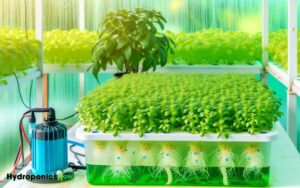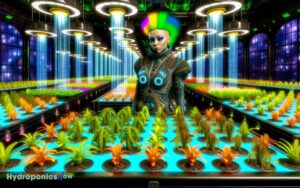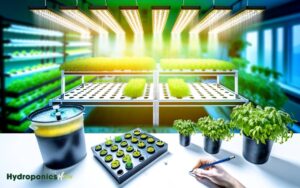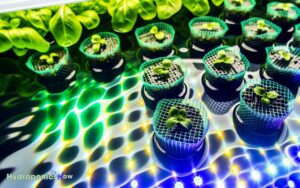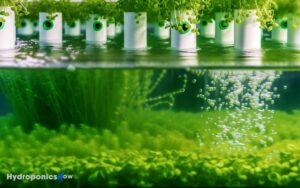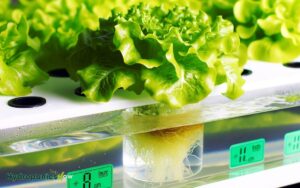Wine Bottle Hydroponic Planter Diy: A Complete Guide
Creating a wine bottle hydroponic planter involves repurposing a cleaned 750 ml bottle as a nutrient reservoir. Drill a hole using a diamond-coated glass bit for a secure wick insertion.
Thread a nylon rope or cotton twine wick through the neck to transport hydroponic nutrient solution to the plant roots. Fill a net pot with sterile hydroponic medium, such as expanded clay pellets, and securely place your herb seedlings so the roots reach the nutrient solution.
Maintain water levels and provide adequate light exposure. For more detailed guidance, further instructions are available.
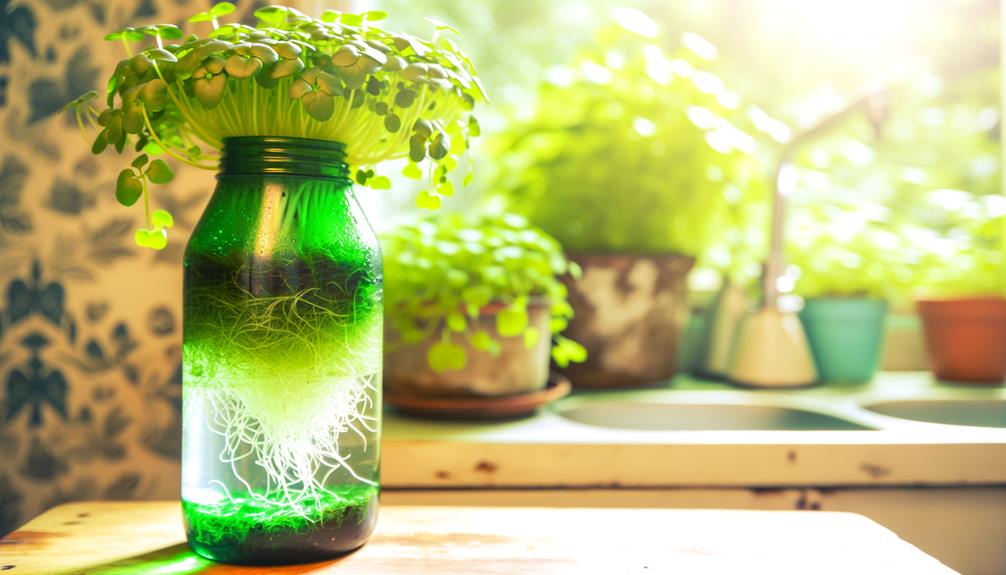
Key Takeaways
- Clean the bottle: Remove labels and adhesive residues for a clear, smooth surface.
- Drill hole: Use a diamond-coated glass drill bit to create a precise hole for the wick.
- Prepare wicking system: Thread a cotton or nylon wick through the bottle neck to transport nutrients.
- Add hydroponic medium: Fill the bottle with rinsed and soaked expanded clay pellets or rockwool.
Materials Needed
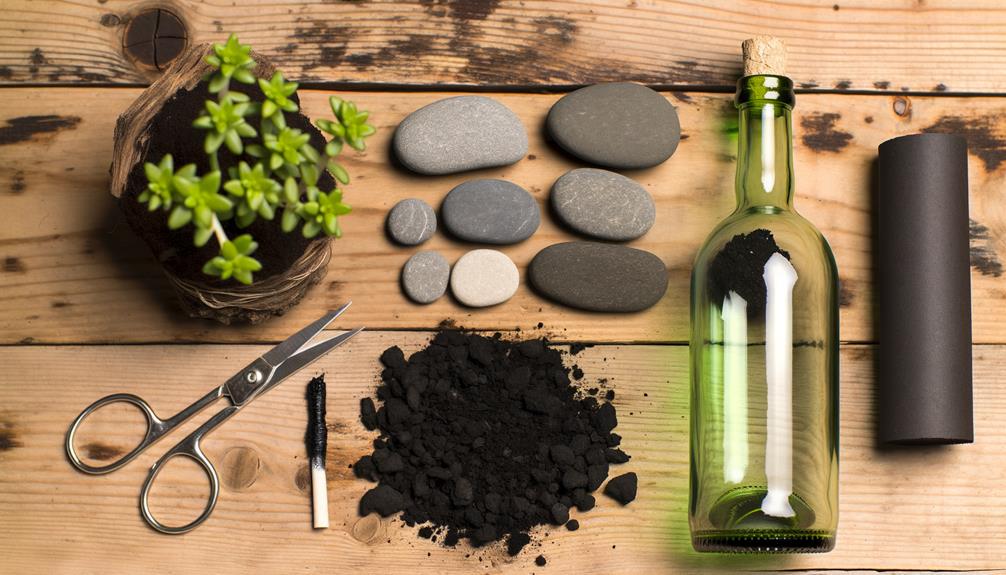
To assemble a DIY wine bottle hydroponic planter, you will need the following materials:
- A used wine bottle (750 ml)
- A diamond-coated glass drill bit
- Hydroponic nutrient solution
- Cotton string or wicking material
- Net pots (2-inch size)
- Hydroponic growing medium (e.g., expanded clay pellets)
The wine bottle serves as the primary reservoir for the nutrient solution, while the diamond-coated drill bit is crucial for creating precise holes without fracturing the glass.
The cotton string acts as a wick, transporting nutrients to the plant’s roots. Net pots hold the growing medium and the plant securely.
Hydroponic growing medium guarantees proper aeration and support, facilitating ideal root development and nutrient uptake.
Preparing the Wine Bottle
Carefully clean and remove any labels from the wine bottle to guarantee a smooth surface for drilling.
Begin by soaking the bottle in warm, soapy water for approximately 30 minutes to loosen the adhesive.
Utilize a razor blade or scraper to remove residual label fragments.
For stubborn adhesive remnants, apply a mixture of baking soda and vegetable oil, then scrub gently.
Once label-free, rinse the bottle thoroughly and allow it to dry completely.
Employ fine-grit sandpaper to smooth any rough edges on the bottle’s surface.
Verify the bottle is structurally sound, devoid of cracks or chips, as these imperfections could compromise the integrity of the planter.
This meticulous preparation is essential for the subsequent drilling and assembly stages.
Setting Up the Wick System
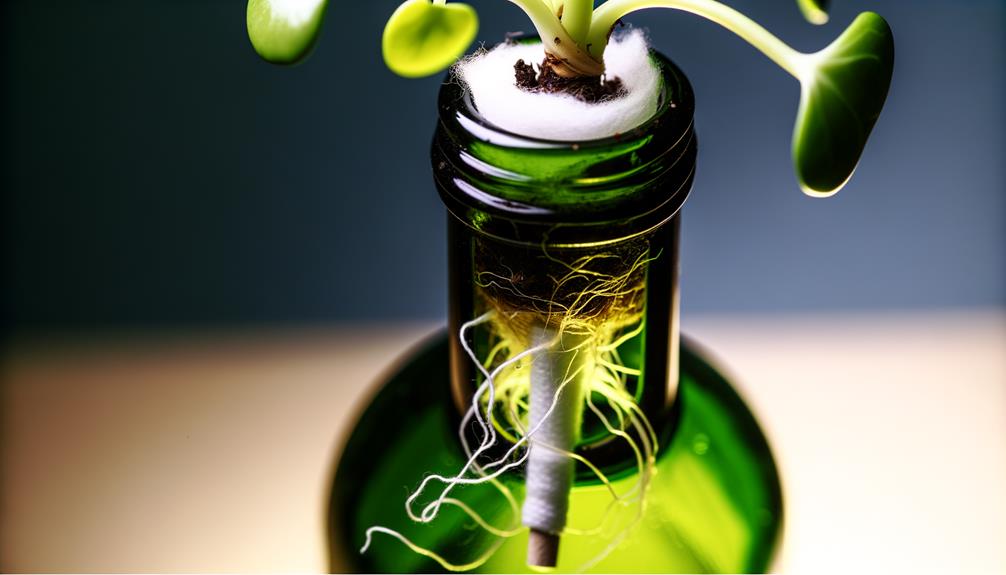
Establishing an efficient wick system is essential for maintaining consistent nutrient and water delivery to the plant roots in your hydroponic planter.
Begin by selecting an appropriate wick material, such as nylon rope or cotton twine, which guarantees peak capillary action.
Cut the wick to a length that allows it to reach from the nutrient solution reservoir at the bottom of the wine bottle to the plant roots in the upper section.
Thread the wick through the neck of the bottle, making sure it is securely positioned.
The wick should rest in the nutrient solution while extending upwards into the grow area, where it will maintain a moist environment for the roots.
This setup guarantees a continuous transfer of nutrients and water, promoting healthy plant growth.
Adding the Hydroponic Medium
Selecting an appropriate hydroponic medium is essential for ideal root support and nutrient delivery.
Begin by choosing a medium such as expanded clay pellets, perlite, or rockwool, ensuring it is sterile and free of contaminants.
Thoroughly rinse the chosen medium to remove any dust or debris before filling the planter to facilitate maximum root aeration and nutrient uptake.
Choosing Hydroponic Medium
When adding the hydroponic medium, it is essential to take into account its properties such as water retention, aeration, and pH neutrality to guarantee ideal plant growth.
Best choices include expanded clay pellets, rock wool, and perlite.
Expanded clay pellets offer excellent aeration and pH neutrality, making them a preferred choice.
Rock wool, derived from molten rock, provides superior water retention and root support but requires pH adjustment.
Perlite, a volcanic glass, is lightweight and enhances aeration, though it lacks substantial water retention.
Each medium presents unique advantages; therefore, selecting the appropriate medium hinges on the specific requirements of the plant species you intend to cultivate.
Ensuring the right balance will foster robust hydroponic systems in your wine bottle planters.
Preparing the Medium
To guarantee ideal performance of your hydroponic system, begin by thoroughly rinsing the chosen medium to remove any dust or impurities that could hinder nutrient absorption.
Employ distilled water for this process to make certain no additional contaminants are introduced. The medium should be soaked for a minimum of 24 hours to fully hydrate and be prepared for nutrient uptake.
Key steps include:
- Rinse the medium: Use a fine mesh strainer to wash the medium under running distilled water until the water runs clear.
- Soak the medium: Submerge the medium in distilled water for at least 24 hours to make certain complete hydration.
These steps will make certain your hydroponic medium is ideally prepared.
Filling the Planter
After thoroughly preparing and hydrating the medium, proceed by carefully filling the wine bottle planter with the rinsed and soaked substrate, ensuring an even distribution to support the plant roots effectively.
Begin by introducing a small layer of the hydroponic medium, such as expanded clay pellets or perlite, into the base of the bottle. Gradually add more substrate while gently shaking the planter to eliminate air pockets and achieve uniform compaction.
It is essential to maintain a balance, neither overfilling nor compacting too tightly, as this could impede root aeration and nutrient uptake.
Continuously inspect the arrangement to confirm the medium surrounds the plant’s root system adequately, promoting ideal growth conditions within the hydroponic environment.
Planting the Herbs
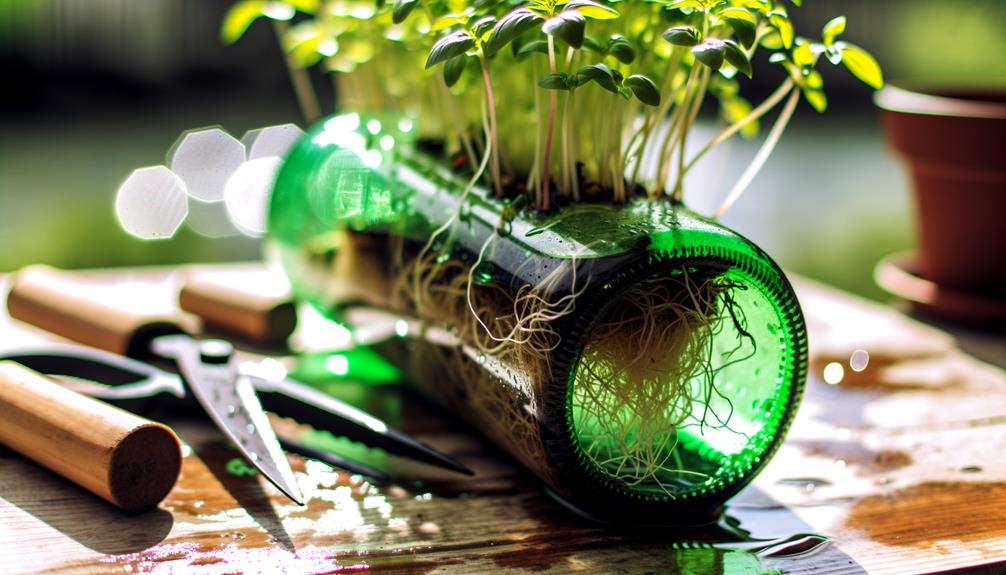
Initiate the planting process by carefully inserting the herb seedlings into the net pots, guaranteeing their roots extend down into the nutrient solution. This step is essential for ideal nutrient uptake and plant stability.
Select herb seedlings that have a well-developed root system and are free from diseases or pests.
- Gently spread the roots to prevent crowding and guarantee even distribution within the net pot.
- Secure the seedlings with a growing medium such as clay pellets or rock wool to provide structural support.
This meticulous procedure fosters an environment conducive to vigorous herb growth, leveraging the hydroponic system’s efficiency.
Maintaining Your Planter
To guarantee the ideal growth of your hydroponic herbs, it is essential to adhere to a consistent watering schedule and monitor the nutrient solution levels regularly. Additionally, maintaining the proper pH balance and ensuring adequate light exposure will support healthy development. If you plan to transition hydroponic basil to soil, gradually introduce it to soil-based conditions by mixing a small amount of soil into the hydroponic medium. This helps the plant adapt to its new environment and reduces transplant shock.
Additionally, providing sufficient light, either through natural sunlight or artificial grow lights, is vital for photosynthesis and overall plant health.
This section will detail the best practices for maintaining a thriving hydroponic system, focusing on these important components.
Watering Schedule Tips
How frequently should the nutrient solution be replenished in your DIY wine bottle hydroponic planter to secure optimal plant growth?
To maintain optimal conditions, it is essential to adhere to a consistent watering schedule. Generally, replenishing the nutrient solution every one to two weeks guarantees that plants receive the necessary minerals and oxygen. Monitoring the water level and quality is equally important.
- Check water levels daily: Maintain a constant water level to prevent root desiccation.
- Monitor pH levels: Ideal pH range is between 5.5 and 6.5 for most hydroponic plants.
Nutrient Solution Guide
Ensuring the efficacy of your nutrient solution is paramount for the thriving growth of plants in your DIY wine bottle hydroponic planter.
Begin by selecting a balanced hydroponic nutrient mix containing essential macronutrients (N, P, K) and micronutrients (Fe, Mn, Zn, Cu, Mo).
Dissolve the nutrients in distilled water, ensuring a pH range of 5.5 to 6.5, as this range enhances nutrient uptake.
Utilize a TDS (Total Dissolved Solids) meter to maintain a prime concentration of 800-1200 ppm, depending on the plant species.
Regularly monitor and adjust the solution every two weeks to prevent nutrient imbalances.
Replace the solution entirely monthly to avoid the accumulation of salts and contaminants, ensuring a consistent supply of crucial nutrients.
Light Source Recommendations
Proper lighting is essential for the perfect growth of plants in your DIY wine bottle hydroponic planter. Ensuring an ideal light spectrum and intensity considerably influences photosynthesis and plant health.
For efficient growth, employ full-spectrum LED grow lights, as they offer the necessary wavelengths and are energy-efficient. Position these lights approximately 6-12 inches above the plants to avoid light burn while ensuring adequate light penetration.
Consider the following lighting options:
- Full-Spectrum LED Lights: Mimic natural sunlight, ideal for all growth stages.
- Fluorescent Grow Lights: Cost-effective, suitable for smaller setups.
Regularly monitor light exposure duration, aiming for 12-16 hours per day to maintain a consistent photoperiod.
Conclusion
The transformation of a wine bottle into a hydroponic planter signifies the convergence of sustainability and innovation. This process, akin to alchemy, breathes new life into a discarded object, nurturing herbs within its glass confines.
The wick system symbolizes the thread of life, channeling essential nutrients, while the hydroponic medium serves as the fertile ground for growth.
Such an endeavor not only cultivates greenery but also embodies ecological harmony and resourcefulness, underscoring the potential of creative repurposing in sustainable practices.

